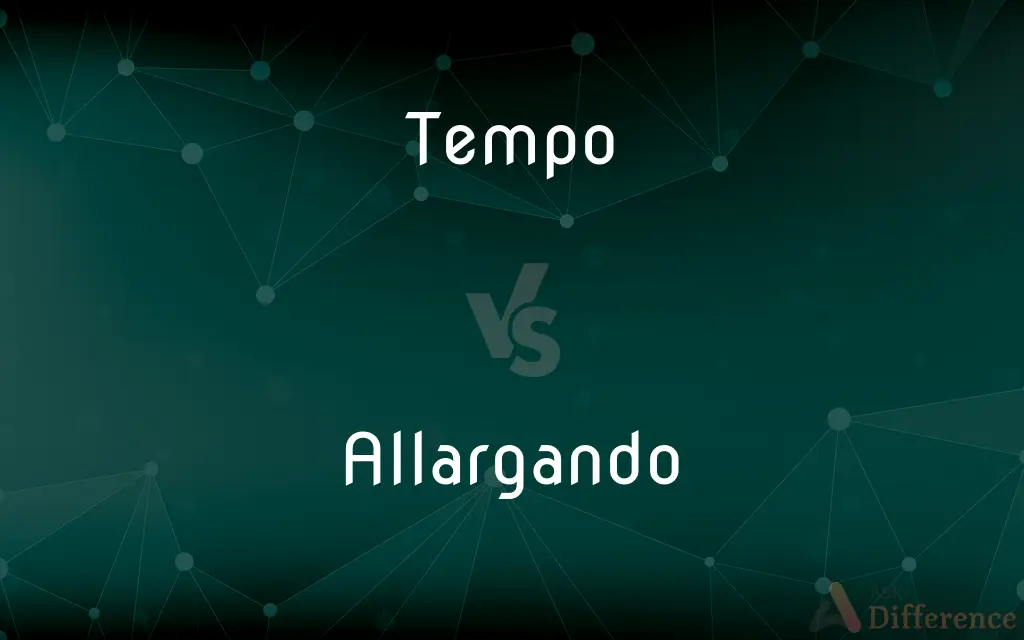Tempo vs. Allargando — What's the Difference?
Edited by Tayyaba Rehman — By Fiza Rafique — Updated on April 16, 2024
Tempo refers to the speed at which music is played, typically measured in beats per minute; allargando, a tempo alteration, means gradually slowing down and broadening the performance.

Difference Between Tempo and Allargando
Table of Contents
ADVERTISEMENT
Key Differences
Tempo is a fundamental music concept indicating the speed or pace of a given piece, usually defined in beats per minute (BPM). Whereas allargando refers to a specific instruction in musical performance, directing the performer to gradually slow the tempo and often broaden the expression, adding a richer dynamic.
In music notation, tempo is often marked at the beginning of a score by terms like "Allegro" or "Andante" or numerically indicated by a metronome mark. On the other hand, allargando is used to modify these initial tempos, suggesting a temporary change that affects the mood and intensity of the music.
Performers rely on the tempo to determine the piece’s rhythmic structure and to maintain consistency throughout the performance. Meanwhile, allargando allows for expressive flexibility, letting performers emphasize certain sections of the piece more dramatically by slowing down.
Tempo can be altered by other terms like "accelerando" or "ritardando," which also instruct speed changes but do not necessarily imply the broadening effect of allargando, which uniquely combines a decrease in speed with an increase in volume and expression.
Many musical pieces return to their original tempo after a passage in allargando, showcasing its role as a temporary deviation to enhance emotional impact, whereas the overall tempo provides the foundational pace and character of the entire piece.
ADVERTISEMENT
Comparison Chart
Definition
Speed of music, measured in BPM.
A directive to slow down and broaden style.
Role in Performance
Sets consistent pace for a piece.
Introduces expressive flexibility.
Notation
Indicated by specific terms or numbers.
Marked as 'allargando' in the score.
Impact on Dynamics
Does not imply dynamic changes.
Often involves an increase in dynamics.
Relation to Structure
Fundamental to the piece’s rhythm.
Temporarily alters the established rhythm.
Compare with Definitions
Tempo
A measure of time in music, defining the speed at which a piece is played.
The tempo of the sonata was marked as Allegro.
Allargando
A musical term directing a gradual slowing of tempo and increase in volume.
The allargando passage allowed the soloist to shine.
Tempo
A crucial element in musical expression and structure.
A consistent tempo is essential for the ensemble’s synchronicity.
Allargando
Used to enhance the emotional expressiveness of a piece.
The allargando brought a dramatic depth to the final chorus.
Tempo
Can be modified by directives like accelerando or ritardando for dramatic effect.
The tempo slowed dramatically as the movement progressed.
Allargando
Not a permanent change but a temporary deviation in performance.
After the allargando, the tempo returned to its original pace.
Tempo
The pace set by the conductor or a metronome in a musical performance.
The choir adjusted as the conductor increased the tempo.
Allargando
Requires sensitivity and control from the performer to execute effectively.
Her skilled allargando interpretation moved the audience.
Tempo
Often predetermined by the composer to convey a specific mood or theme.
The lively tempo matched the joyful theme of the festival.
Allargando
Often coincides with the climax or a particularly expressive part of the music.
The music swelled and broadened at the allargando.
Tempo
In musical terminology, tempo (Italian for "time"; plural tempos, or tempi from the Italian plural) is the speed or pace of a given piece. In classical music, tempo is typically indicated with an instruction at the start of a piece (often using conventional Italian terms) and is usually measured in beats per minute (or bpm).
Allargando
In a gradually broadening style and slowing tempo. Used chiefly as a direction.
Tempo
(Music) The speed at which music is or ought to be played, often indicated on written compositions by a descriptive or metronomic direction to the performer.
Allargando
(music) Decreasing in tempo; getting slower.
Tempo
A characteristic rate or rhythm of activity; a pace
"the tempo and the feeling of modern life" (Robert L. Heilbroner).
Allargando
Gradually decreasing in tempo and broadening in manner
Tempo
A frequency or rate.
10 calls per hour isn't a bad start, but we'll need to up the tempo if we want to reach our target of selling insurance policies.
Tempo
(chess) A move which is part of one's own plan or strategy and forces, e.g. by means of a check or attacking a piece, the opponent to make a move which is not bad but of no use for him (the player gains a tempo, the opponent loses a tempo), or equivalently a player achieves the same result in fewer moves by one approach rather than another.
Tempo
(bridge) The timing advantage of being on lead, thus being first to initiate a strategy to develop tricks for one's side.
Tempo
The timing of a particular event – earlier or later than in an alternative situation (as in chess example)
Tempo
(music) The number of beats per minute in a piece of music; also, an indicative term denoting approximate rate of speed in written music (examples: allegro, andante)
Tempo
(cycling) The steady pace set by the frontmost riders.
Tempo
A small truck or cargo van with three or four wheels, commonly used for commercial transport and deliveries (particularly in Asian and African countries): a genericized trademark, originally associated with the manufacturer Vidal & Sohn Tempo-Werke GmbH.
Tempo
(American football) A rapid rate of play by the offense resulting from reducing the amount of time which elapses after one play ends and the next starts.
Tempo
A temporary carport.
Tempo
The rate or degree of movement in time.
Tempo
(music) the speed at which a composition is to be played
Tempo
The rate of some repeating event
Common Curiosities
Can the tempo change within a piece?
Yes, composers often specify changes like accelerando or ritardando to adjust the tempo.
Does allargando imply a change in dynamics?
Yes, it typically involves both a slowing of tempo and an increase in loudness.
Is allargando a common musical directive?
It is less common than basic tempo changes but is used effectively for dramatic emphasis.
How does allargando affect a musical performance?
Allargando instructs the performer to gradually slow the pace and increase the volume, adding expressiveness.
How is tempo indicated in music?
It can be explicitly marked by terms or a metronome setting at the beginning of a score.
What does allargando mean for a conductor?
It means guiding the orchestra through a gradual and expressive tempo and dynamic change.
How does a composer decide on the tempo of a piece?
The tempo is chosen to reflect the mood, style, and context of the music.
What skills are required to perform allargando?
Performers need to have good control over timing and dynamic adjustment.
Can a piece return to its original tempo after allargando?
Yes, it's common to return to the initial tempo after an allargando section.
What is tempo in music?
Tempo is the speed at which a piece of music is played, generally measured in beats per minute.
Can tempo and allargando affect the emotional impact of a piece?
Absolutely, they are essential tools for conveying emotion in music.
Are tempo and allargando mutually exclusive?
No, allargando is a type of tempo change.
Why use allargando instead of just slowing the tempo?
Allargando also enhances the musical expression through dynamic changes.
How do performers keep track of tempo changes like allargando?
Through cues in the score and the conductor's guidance.
What’s the difference between allargando and ritardando?
Ritardando simply slows the tempo, whereas allargando also involves broadening.
Share Your Discovery

Previous Comparison
Futsal vs. Handball
Next Comparison
Freon vs. HalonAuthor Spotlight
Written by
Fiza RafiqueFiza Rafique is a skilled content writer at AskDifference.com, where she meticulously refines and enhances written pieces. Drawing from her vast editorial expertise, Fiza ensures clarity, accuracy, and precision in every article. Passionate about language, she continually seeks to elevate the quality of content for readers worldwide.
Edited by
Tayyaba RehmanTayyaba Rehman is a distinguished writer, currently serving as a primary contributor to askdifference.com. As a researcher in semantics and etymology, Tayyaba's passion for the complexity of languages and their distinctions has found a perfect home on the platform. Tayyaba delves into the intricacies of language, distinguishing between commonly confused words and phrases, thereby providing clarity for readers worldwide.
















































